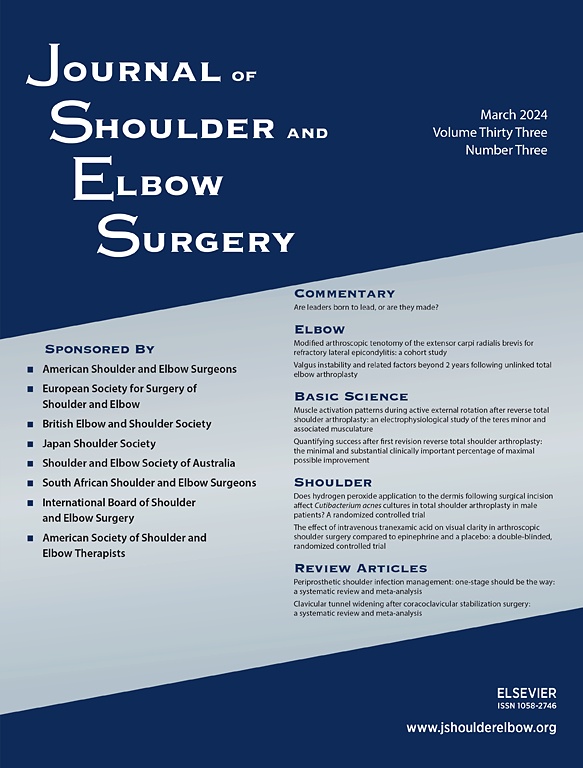
More re-tears after single- compared to double-row rotator cuff repair

More re-tears after single- compared to double-row rotator cuff repair
Clinical and structural outcomes after arthroscopic single-row versus double-row rotator cuff repair: a systematic review and meta-analysis of level I randomized clinical trials
J Shoulder Elbow Surg. 2014 Apr;23(4):586-97. doi: 10.1016/j.jse.2013.10.006. Epub 2014 Jan 8OE EXCLUSIVE
Dr. P.J. Millett discusses the rate of re-tears in single- as compared to double-row rotator cuff repair
Synopsis
7 level I randomized controlled trials comparing single- and double-row rotator cuff repair were included in this meta-analysis. The purpose of this review was to compare the clinical and structural outcomes associated with each treatment approach. Pooled data revealed that single- and double-row anchoring techniques yielded similar American Shoulder and Elbow Surgeons (ASES), the University of California - Los Angeles (UCLA), and Constant scores. Although there were no significant differences between groups with regard to the incidence of full-thickness re-tears, the number of partial-thickness re-tears was significantly higher after single-row repair.
Were the search methods used to find evidence (original research) on the primary question or questions stated?
Was the search for evidence reasonably comprehensive?
Were the criteria used for deciding which studies to include in the overview reported?
Was the bias in the selection of studies avoided?
Were the criteria used for assessing the validity of the included studies reported?
Was the validity of all of the studies referred to in the text assessed with use of appropriate criteria (either in selecting the studies for inclusion or in analyzing the studies that were cited)?
Were the methods used to combine the findings of the relevant studies (to reach a conclusion) reported?
Were the findings of the relevant studies combined appropriately relative to the primary question that the overview addresses?
Were the conclusions made by the author or authors supported by the data and or analysis reported in the overview?
How would you rate the scientific quality of this evidence?
Yes = 1
Uncertain = 0.5
Not Relevant = 0
No = 0
The Reporting Criteria Assessment evaluates the transparency with which authors report the methodological and trial characteristics of the trial within the publication. The assessment is divided into five categories which are presented below.
4/4
Introduction
4/4
Accessing Data
4/4
Analysing Data
3/4
Results
3/4
Discussion
Detsky AS, Naylor CD, O'Rourke K, McGeer AJ, L'Abbé KA. J Clin Epidemiol. 1992;45:255-65
The Fragility Index is a tool that aids in the interpretation of significant findings, providing a measure of strength for a result. The Fragility Index represents the number of consecutive events that need to be added to a dichotomous outcome to make the finding no longer significant. A small number represents a weaker finding and a large number represents a stronger finding.
Why was this study needed now?
Arthroscopic rotator cuff repair can be performed using single- or double-row techniques. Biomechanical studies have found double-row repair to be superior, however conflicting evidence exists regarding the superiority of one technique over the other with respect to clinical and structural outcomes. As previous reviews have included Level II or III evidence, this study was needed to summarize only the evidence of the highest quality (i.e. level I evidence) on this topic.
What was the principal research question?
Is there any significant difference in clinical outcome or the incidence of re-tear between single- and double-row techniques in rotator cuff repair?.
What were the important findings?
- 7 randomized controlled trials (all Level I evidence) were included in this review. (Total patients=567; 285 single-row group and 282 double-row group)
- 3 studies reported the improvement between preoperative and postoperative ASES scores. Pooled data revealed no significant difference between single- and double-row repair for this outcome (WMD -2.1; 95% CI -7.3 to 3.2; p=0.440; I-squared: 0%).
- There was no significant difference between groups with respect to improvement in UCLA scores (3 studies; WMD 1.1; 95% CI -0.3 to 2.5; p=0.116; I-squared: 29%).
- Improvement in Constant scores was pooled in 3 studies. Meta-analysis of this outcome revealed no significant difference between groups for this outcome (WMD -3.7; 95% CI -8.8 to 1.4; p=0.156; I-squared: 0%).
- When all re-tears were considered (i.e. both full- and partial-thickness), the incidence was significantly higher with single-row repair (6 studies; RR 1.76; 95% CI 1.25 to 2.48; p=0.001; I-squared: 0%).
- The incidence of full-thickness re-tears was similar between single- and double-row repair (3 studies; RR 1.03; 95% CI 0.45 to 2.33; p=0.953; I-squared: 0%).
- The incidence of partial-thickness re-tears was significantly higher with single-row repair (3 studies; RR 1.99; 95% CI 1.04 to 3.82; p=0.039; I-squared: 41%).
What should I remember most?
Arthroscopic rotator cuff repair using single- and double-row anchoring techniques yielded similar American Shoulder and Elbow Surgeons (ASES), the University of California - Los Angeles (UCLA), and Constant scores. Although there was no significant difference between groups in the incidence of full-thickness re-tears, the number of partial-thickness re-tears was significantly higher with single-row repair. When both types of re-tears were considered (i.e. full- and partial-thickness), results significantly favoured double-row repair.
How will this affect the care of my patients?
The results from this meta-analysis support the use of double-row rotator cuff repair as clinical outcomes were similar and re-tear rates were significantly lower (especially partial-thickness re-tears) when compared to single-row repair. However, additional high-quality studies are needed to confirm these findings.
Learn about our AI Driven
High Impact Search Feature
Our AI driven High Impact metric calculates the impact an article will have by considering both the publishing journal and the content of the article itself. Built using the latest advances in natural language processing, OE High Impact predicts an article’s future number of citations better than impact factor alone.
Continue



 LOGIN
LOGIN

Join the Conversation
Please Login or Join to leave comments.